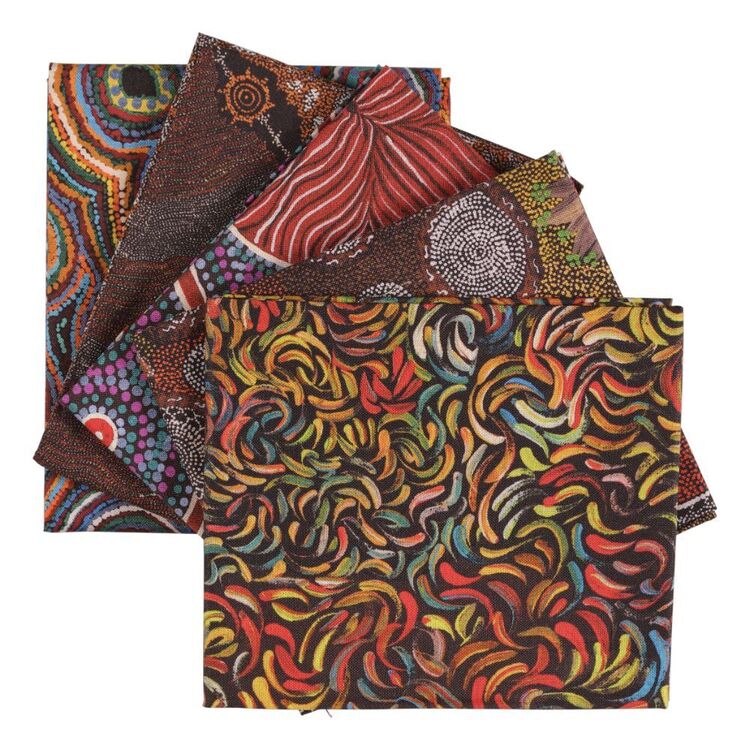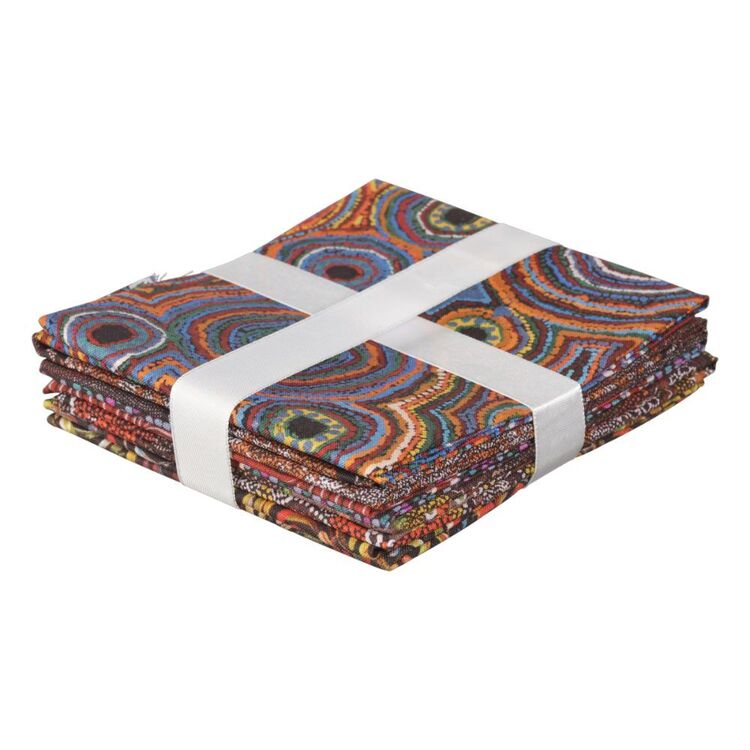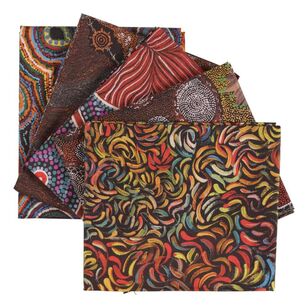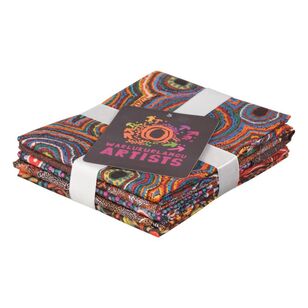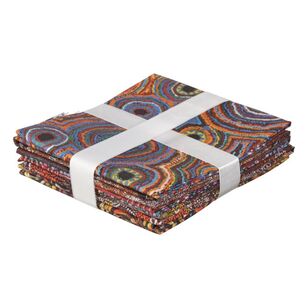 | ||
| Your browser is not supported. | ||
|
Please browse our site using any of the following options:
| ||
Warlukurlangu 5 piece Flat Fat Bundle Multicoloured 50 x 52 cm
PRODUCT OVERVIEW
Introducing our Warlukurlangu Flat Fat Bundle, a delightful assortment of expertly curated fabrics that celebrate Indigenous Australian culture. Dive into the world of quilting with these vibrant five pieces that echo the essence of our brand's commitment to creativity and craftsmanship. This material is composed of 100% cotton. It is supplied in a 112 cm width and sold by the metre. Spotlight has a beautiful range of fabrics, featuring amazing artwork by the talented first nations peoples creating with Warlukurlangu, Artists of Yuendumu.
Napaljarri-warnu Jukurrpa (Seven Sisters Dreaming) by Shanna Napanangka Williams:
The Napaljarri-warnu Jukurrpa (seven sisters Dreaming) depicts the story of the seven ancestral Napaljarri sisters who are found in the night sky today in the cluster of seven stars in the constellation Taurus, more commonly known as the Pleiades. The Pleiades are seven women of the Napaljarri skin group and are often depicted in paintings of this Jukurrpa carrying the Jampijinpa man 'wardilyka' (the bush turkey [Ardeotis australias]) who is in love with the Napaljarri-warnu and who represents the Orion's Belt cluster of stars. Jukurra-jukurra, the morning star, is a Jakamarra man who is also in love with the seven Napaljarri sisters and is often shown chasing them across the night sky. In a final attempt to escape from the Jakamarra the Napaljarri-warnu turned themselves into fire and ascended to the heavens to become stars. The custodians of the Napaljarri-warnu Jukurrpa are Japaljarri/Jungarrayi men and Napaljarri/Nungarrayi women. Some parts of the Napaljarri-warnu Jukurrpa are closely associated with men's sacred ceremonies of a very secretive nature. In contemporary Warlpiri paintings traditional iconography is used to represent the Jukurrpa, associated sites and other elements. Often depicted in paintings for this Jukurrpa is the female star Yantarlarangi (Venus - the Evening Star) who chases the seven Napaljarri sisters for having stolen the night from her.
Ngapa Jukurrpa (Water Dreaming) - Puyurru by Ada Nangala Dixon
The site depicted in this painting is Puyurru, west of Yuendumu. In the usually dry creek beds are 'mulju' (soakages), or naturally occurring wells. The 'kirda' (owners) for this site are Nangala/Nampijinpa women and Jangala/Jampijinpa men. Two Jangala men, rainmakers, sang the rain, unleashing a giant storm. The storm travelled across the country from the east to the west, initially travelling with a 'pamapardu Jukurrpa' (termite Dreaming) from Warntungurru to Warlura, a waterhole 8 miles east of Yuendumu. At Warlura, a gecko called Yumariyumari blew the storm on to Lapurrukurra and Wilpiri. Bolts of lightning shot out at Wirnpa (also called Mardinymardinypa) and at Kanaralji. At this point the Dreaming track also includes the 'kurdukurdu mangkurdu Jukurrpa' (children of the clouds Dreaming). The water Dreaming built hills at Ngamangama using baby clouds and stuck long pointy clouds into the ground at Jukajuka, where they can still be seen today as rock formations.
The termite Dreaming eventually continued west to Nyirripi, a community approximately 160 km west of Yuendumu. The water Dreaming then travelled from the south over Mikanji, a watercourse with soakages northwest of Yuendumu. At Mikanji, the storm was picked up by a 'kirrkarlanji' (brown falcon [Falco berigora]) and taken farther north. At Puyurru, the falcon dug up a giant 'warnayarra' (rainbow serpent). The serpent carried water with it to create another large lake, Jillyiumpa, close to an outstation in this country. The 'kirda' (owners) of this story are Jangala men and Nangala women. After stopping at Puyurru, the water Dreaming travelled on through other locations including Yalyarilalku, Mikilyparnta, Katalpi, Lungkardajarra, Jirawarnpa, Kamira, Yurrunjuku, and Jikaya before moving on into Gurindji country to the north.
In contemporary Warlpiri paintings, traditional iconography is used to represent the 'Jukurrpa' (Dreaming). Short dashes are often used to represent 'mangkurdu' (cumulus & stratocumulus clouds), and longer, flowing lines represent 'ngawarra' (flood waters). Small circles are used to depict 'mulju' (soakages) and riverbed.
Purrpalanji (Skinny Bush Banana) Jukurrpa by Nola Napangardi Fisher
'Purrpalanji' (skinny bush banana [Rhyncharrhena linearis]) is a twining climber with thin leaves and pink-brown flowers. Its bean-like edible pods are long and skinny and can grow up to 20 cm long. It is fire tolerant and grows quickly whenever moisture is available. Like 'yuparli' (bush banana [Marsdenia australis]), all of the plant is eaten aside from the woody stems.
This 'purrpalanji Jukurrpa' (skinny bush banana Dreaming) comes from Pikilyi (Vaughan Springs), a large waterhole and natural spring to the west of Yuendumu, close to Mount Doreen. Napangardi/Napanangka women and Japangardi/Japanangka men are the 'kirda' (owners) of the skinny bush banana Dreaming at Pikilyi. Nangala women and Jangala men are the 'kurdungurlu' (custodians) of this Dreaming.
Napangardi and Napanangka women collect 'purrpalanji' (skinny bush banana) and 'yuparli' (bush banana) around Pikilyi in their 'parraja' (coolamons). They cook the 'purrpalanji' and 'yuparli' in hot ashes to get rid of the acidic taste they can have when eaten raw. The skinny bush banana Dreaming is only associated with Pikilyi and does not travel to other locations. Pikilyi is an important site associated with several different Dreamings. These include 'yuparli Jukurrpa' (bush banana Dreaming), 'warrilyi ngurlu Jukurrpa' (blue mallee [Eucalyptus polybractea] seed Dreaming), 'kakalyalya Jukurrpa' (cockatoo Dreaming), and 'warna-jarra Jukurrpa' (two snakes Dreaming). In the two snakes Dreaming story, Napangardi and Napanangka women picked lice off the two snakes living in the waterhole at Pikilyi.
In Warlpiri paintings, traditional iconography is used to represent the Jukurrpa and other elements. Curved lines are used to represent the long, skinny edible portion of the 'purrpalanji' (skinny bush banana).
Ngapa Jukurrpa (Water Dreaming) - Mikanji by Lola Nampijinpa Brown
The country associated with this 'ngapa Jukurrpa' (water Dreaming) is Mikanji, a watercourse west of Yuendumu that is usually dry. There are 'mulju' (soakages) in this creek bed. The 'kirda' (owners) of this Dreaming site are Nangala/Nampijinpa women and Jangala/Jampijinpa men. Mikanji is an important water Dreaming site, and features in at least three different water Dreaming tracks.
In one story, the water Dreaming travelled from Puyurru, northwest of Yuendumu, to a 'mulju' (soakage) in the Mikanji creek. It unleashed a huge storm there. Two old blind women of the Nampijinpa skin group were sitting by the side of the soakages. As the two women strained their eyes to see the sky, tears formed in their eyes, creating the rain. Their spirits can still be seen at Mikanji in the form of two 'ngapiri' (river red gums) growing near the soakage.
A second water Dreaming track that passes through Mikanji is also owned by the Nangala/Jangala and Nampijinpa/Jampijinpa subsections, and travels further west. At Mikanji, the storm rained so hard it created a hole in the ground which became a soakage. At Mirawarri a 'kirrkarlanji' (brown falcon [Falco berigora]) picked up the storm and carried it on its wings to the west until it became too heavy for it. The falcon eventually dropped the storm at Pirlinyarnu (Mt. Farewell) about 165 km west of Yuendumu, where it formed an enormous 'maluri' (claypan). A 'mulju' (soakage) exists in this place today.
A third Dreaming track that passes through Mikanji is the story of the water Dreaming and 'pamapardu Jukurrpa' (termite Dreaming). This Dreaming travels further north. This water Dreaming is owned by Nakamarra/Napurrurla women and Jakamarra/Jupurrurla men. The termite and water Dreamings travelled together from Warntungurru in the east past Warlura (a waterhole 8 miles east of Yuendumu), Wirnpa, Kanaralji, Ngamangama, and Jukajuka. A portion of this Dreaming track also includes the 'kurdukurdu mangkurdu Jukurrpa' (children of the clouds Dreaming). The termite Dreaming moved on to the west to Nyirrpi, a community approximately 160 km west of Yuendumu.
Ngalyipi Jukurrpa (Snake Vine Dreaming) – Purturlu by Ingrid Napangardi Williams
The 'ngalyipi Jukurrpa' (snakevine [Tinospora smilacina] Dreaming) depicted in this painting comes from Purturlu (Mount Theo), located approximately 150kms north-northwest of Yuendumu. The 'kirda' (owners) of this Dreaming are Napanangka/Napangardi women and Japanangka/Japangardi men. The 'kurdungurlu' (custodians) for this Dreaming are Nangala/Nakamarra women and Jangala/Jakamarra men. Several other Dreamings are also located in, or pass through, Purturlu, these include 'wakurlpirri Jukurrpa' (Dogwood tree Dreaming), 'wardapi Jukurrpa' (goanna Jukurrpa), and 'kanta Jukurrpa' (bush coconut Dreaming).
'Ngalyipi' (snakevine) is a green creeper that climbs up the trunks and branches of trees and shrubs. The plant is found on sandy spinifex plains and sandhills. 'Ngalyipi' is frequently depicted in paintings due to its many uses and its great importance in the initiation ceremonies of young Japanangka/Japangardi men. The vine can be used as a shoulder strap to carry 'parraja' (coolamons) and 'ngami' (water carriers). The plant also has medicinal uses, its vines are used as tourniquets, and its leaves and vines are used as bandages for wounds. Warlpiri sometimes also chew the leaves to treat severe colds. 'Ngalyipi' stems can be pounded between stones and tied around the forehead to cure headaches. In men's initiation, 'ngalyipi' is used to tie the 'witi' (ceremonial poles) to the shins of the dancing initiates, and to tie 'yukurruyukurru' (dancing boards) to dancers' bodies. The initiation ceremonies associated with the 'ngalyipi' Dreaming at Purturlu are for the sons and grandsons of Japanangka and Japangardi men. Napanangka and Napangardi women dance at these ceremonies, and then look away and block their ears when the men dance. This 'witi' ceremony is performed at night under the stars.
In contemporary Warlpiri paintings, traditional iconography can be used to represent the Jukurrpa, particular sites, and other elements. In many paintings of this Jukurrpa, sinuous lines are used to represent the 'ngalyipi' (snake vine). Straight lines are used to represent the 'witi' (ceremonial poles) and 'karlangu' (digging sticks).
Reg: $35
VIP $17.50




